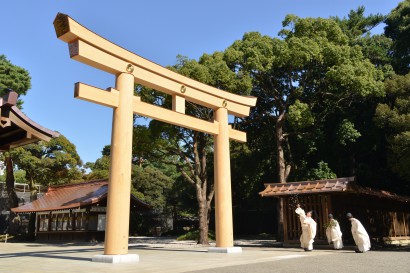Visit the exhibition devoted to Meiji Jingu – a Shinto religion shrine located in the centre of Tokyo. The photographs presented in the Open-Air Gallery in Agrykoli street in Warsaw will show Japanese shrine and priests during ceremonies as well as events taking place there.
Shinto is the traditional religion of Japan, deeply rooted in the way of Japanese life. It has no founder, no holy book and not even the concept of religious conversion, yet it has values – harmony with nature, and virtues, such as Magokoro (sincere heart).
The Shinto deities, called Kami, can be found in mythology, in nature and in human beings. As early as in ancient times, the Japanese felt awe and gratitude towards Kami and erected shrines to many of them.
The Meiji shrine is dedicated to the divine souls of Emperor Meiji and his consort – Empress Shoken. Emperor Meiji (1852-1912) was the 122nd ruler of Japan. He succeeded to the throne in 1867 at the time when Japan had to face many challenges, including opening the country to the world following a long period of isolation under the Tokugawa shogunate.
Emperor Meiji began to promote friendship with other countries, the western civilization and advanced technologies, at the same time preserving the Japanese identity. In this way, he laid the foundations of contemporary Japan.
Supporting her husband, Empress Shoken (1850-1914) promoted social care and education of women. She donated the ‘Shoken Fund’ to the Red Cross; it has supported social projects until today.
After the death of the Imperial couple, the Japanese decided to commemorate the virtues of the Emperor and the Empress and to venerate them forever. So they donated 100,000 trees and worked as volunteers to create the forest; the Meiji Jingu shrine was opened on 1 November 1920.
